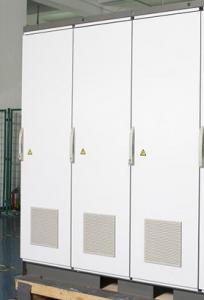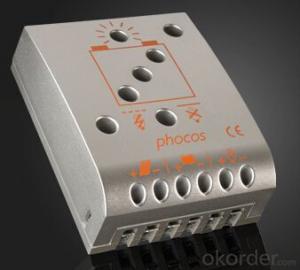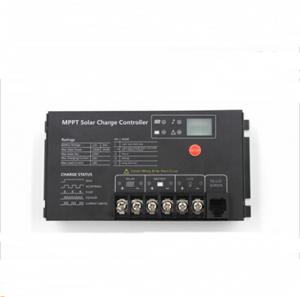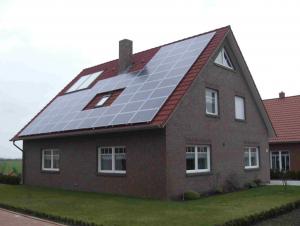Solar Water Pump Controller for Solar System
- Loading Port:
- Shekou
- Payment Terms:
- TT OR LC
- Min Order Qty:
- 20 unit
- Supply Capability:
- 800000 unit/month
OKorder Service Pledge
OKorder Financial Service
You Might Also Like
Products
Solar Pumping System can be applied to daily use (ground water), agricultural irrigation, forestry irrigation, desert control, pasture animal husbandry, water supply for islands, wastewater treatment engineering, and so on. Solar water pump System is dispensed with energy storing devices, and stores water instead of electricity. It improves the reliability of the device, at the same time, it lowers the construction and maintenance costs of the irrigation system dramatically.
In recent years, with the promotion of the utilization of new energy resources, Solar Pumping System is more and more used in municipal engineering, city centre squares, parks, tourist sites, resorts and hotels, the landscapes and fountain irrigation systems in the residential areas.
Technical Features
Optimization of Single Pump System
A single solar irrigation system consists of only one pump, a power -matched solar array and an inverter . The aim of optimization is to reduce the amount of PV modules as much as possible on the premise of filling the requirement of head and capacity. The rotational speed of pump is regulated according to the irradiation on the solar array; when the sunlight reaches its peak, the pump runs at the rated speed, and the output approaches the peak power of the solar array; when the sunlight is less abundant, the speed of pump varies bellow the range of the rated speed; when the speed as low as the capacity becomes zero, the solar pumping system stops working. So, there are big differences between solar irriation systems and traditional pumping systems in system design, and the system should be optimized according to the requirements of head, capacity, and local conditions of sunlight.
•Determine the optimal average daily operating time and the range of speed governing.
•Choose the optimal head and capacity of the pump.
•Determine the maximum power of PV modules, the best working voltage and method of connection.
Optimization of Multi-pump Systems:
There are several pumps in a multi-pump system. The pumps can be driven either by only one high-power inverter, or by several matching inverters. In the case of large capacity demand, the operation of the multi-pump system is more flexible. By switching solar arrays and pumps, all of the pumps run in MPPT mode when the sunlight is abundant, while some pumps will be shut down and all solar arrays supply power intensively for the rest running pumps when irradiation is weak. Based on the optimization of single pump system, the range of speed can be further optimized, and the photovoltaic(PV) pumping system always works with high efficiency.
Product Specifications
Model | Rated Power ( kW ) | Rated Voltage ( V ) | Head ( M ) | Daily Flow ( ㎥/ D ) |
PS370 | 0.37 | 220 | 20-47 | 20-1 |
PS550 | 0.55 | 220 | 15-70 | 40-1 |
PS750 | 0.75 | 220 | 6-81 | 100-1 |
PS1100 | 1.1 | 220 | 8-93 | 100-1 |
PS1500 | 1.5 | 220 | 7-128 | 130-1 |
PS2200 | 2.2 | 380 | 12-163 | 130-1 |
PS3000 | 3 | 380 | 9-187 | 250-10 |
PS4000 | 4 | 380 | 6-225 | 500-10 |
PS5500 | 5.5 | 380 | 10-172 | 500-20 |
PS7500 | 7.5 | 380 | 15-237 | 500-20 |
PS9200 | 9.2 | 380 | 20-140 | 500-40 |
PS11000 | 11 | 380 | 23-159 | 500-40 |
PS13000 | 13 | 380 | 27-189 | 500-40 |
PS15000 | 15 | 380 | 31-208 | 500-40 |
PS18500 | 18.5 | 380 | 39-143 | 500-100 |
PS22000 | 22 | 380 | 25-86 | 700-210 |
PS26000 | 26 | 380 | 30-105 | 700-210 |
PS30000 | 30 | 380 | 35-125 | 700-210 |
PS37000 | 37 | 380 | 40-150 | 700-210 |
PS45000 | 45 | 380 | 50-180 | 700-210 |
PS55000 | 55 | 380 | 65-200 | 700-210 |
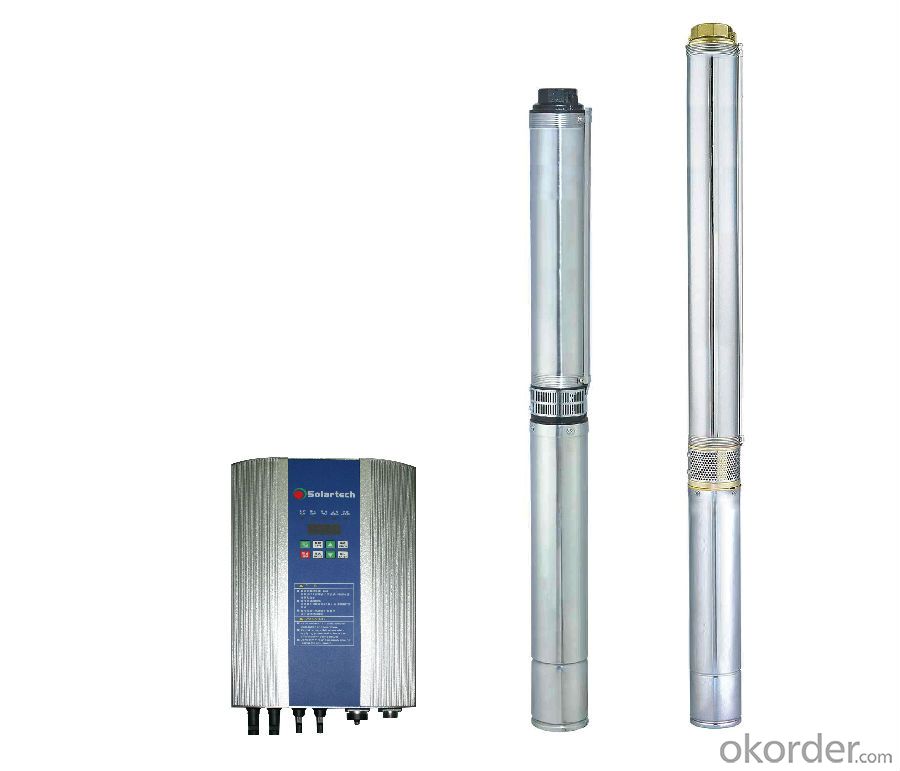
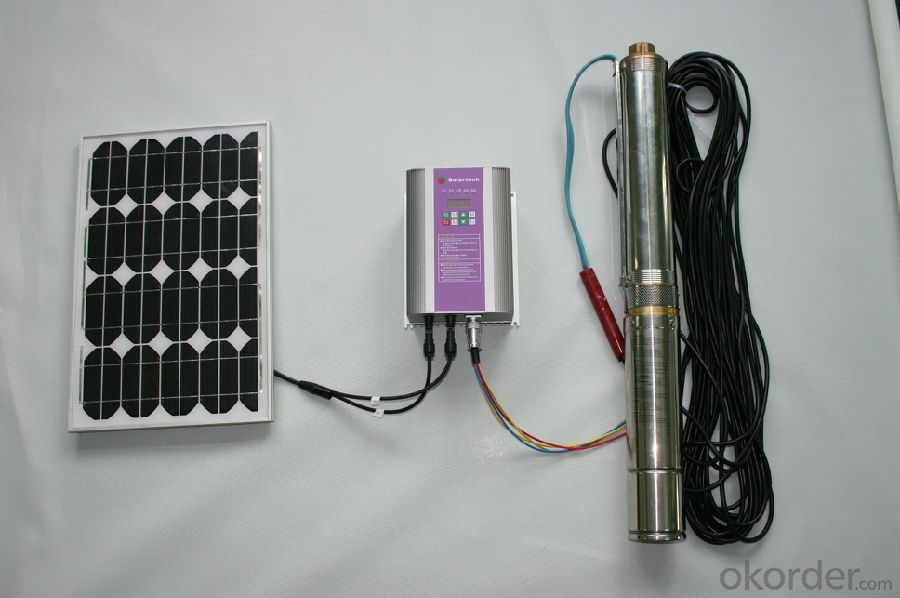
- Q:How does a solar controller handle battery short circuit protection?
- A solar controller typically handles battery short circuit protection by incorporating a built-in feature that automatically detects and prevents any short circuit conditions within the battery. It achieves this by monitoring the current flow and voltage levels within the battery. If a short circuit occurs, the controller immediately disconnects the battery from the solar panel to prevent damage and potential hazards.
- Q:What is the maximum discharge current of a solar controller?
- The maximum discharge current of a solar controller denotes the highest current that can be extracted from the battery by the connected load or device in a solar power system. This value is determined by the design and specifications of the specific solar controller in use. Different solar controllers possess varying maximum discharge current ratings, typically ranging from a few amps to several hundred amps. When choosing a solar controller, it is crucial to take into account the maximum discharge current to ensure that it can handle the power requirements of the connected load. Exceeding the maximum discharge current can result in overheating and potential damage to the solar controller or the connected devices. The manufacturer typically specifies the maximum discharge current, which can be located in the product's technical specifications or user manual. Additionally, it is important to consider the capacity of the battery bank while determining the maximum discharge current. The battery must be capable of supplying the required current without being excessively depleted or damaged. To summarize, the maximum discharge current of a solar controller denotes the highest amount of current that can be drawn from the battery by the connected load. It is vital to select a solar controller with an appropriate maximum discharge current rating to ensure compatibility and proper operation of the solar power system.
- Q:Can a solar controller be used with solar panels of different sizes?
- Yes, a solar controller can be used with solar panels of different sizes. The role of the solar controller is to regulate the charging and discharging of the batteries, and it is compatible with a range of solar panel sizes and configurations. However, it is important to ensure that the solar controller is appropriately sized and can handle the maximum voltage and current of the connected solar panels.
- Q:Can a solar controller be used in a solar-powered swimming pool system?
- Yes, a solar controller can be used in a solar-powered swimming pool system. A solar controller is responsible for regulating the flow of electricity from solar panels to the pool's pump and other electrical components. It helps in optimizing the efficiency of the pool system by ensuring adequate power supply, monitoring battery levels, and protecting the system from overcharging or overheating.
- Q:Can a solar controller be used with a solar-powered emergency backup system?
- Yes, a solar controller can be used with a solar-powered emergency backup system. A solar controller regulates the flow of energy from the solar panels to the battery, ensuring efficient charging and protecting the battery from overcharging or damage. This is crucial in an emergency backup system as it helps to optimize the power generated by the solar panels and maintain the battery's health, ensuring reliable and sustainable backup power during emergencies.
- Q:What is the purpose of the battery low voltage disconnect feature on a solar controller?
- The purpose of the battery low voltage disconnect feature on a solar controller is to protect the batteries from being completely discharged. When the voltage of the batteries drops below a certain threshold, typically around 11.5 volts, the disconnect feature automatically shuts off the power supply from the solar panels to the batteries. This prevents the batteries from being over-discharged, which can lead to irreversible damage and significantly reduce their lifespan. By disconnecting the solar panels when the battery voltage is low, the feature ensures that there is always a minimum charge level maintained in the batteries. This is particularly important in off-grid solar systems, where the batteries are the primary source of power during periods of low or no sunlight. Without the low voltage disconnect, the batteries could be depleted to a level where they cannot be recharged effectively, leaving the system without power until the batteries are replaced. In addition to protecting the batteries, the low voltage disconnect feature also helps to prevent other system components, such as inverters and charge controllers, from being damaged due to low voltage conditions. It acts as a safeguard by interrupting the power flow when the voltage drops too low, preventing potential malfunctions and failures in the system. Overall, the purpose of the battery low voltage disconnect feature on a solar controller is to ensure the longevity and optimal performance of the batteries, as well as to protect the entire solar system from potential damage and operational issues caused by low voltage conditions.
- Q:Can a solar controller be used with a solar-powered electric fence energizer?
- Yes, a solar controller can be used with a solar-powered electric fence energizer. A solar controller helps regulate and control the flow of energy from the solar panels to the energizer, ensuring optimal charging and performance of the electric fence system.
- Q:What is the maximum load voltage in standby mode of a solar controller?
- When a solar controller is in standby or idle mode, the maximum load voltage refers to the highest voltage that can be applied to the load terminals. During this mode, the controller is not actively regulating the battery's charging or discharging, but it remains connected to the load. Typically, the maximum load voltage in standby mode of a solar controller matches the system voltage. For instance, if the solar system operates at 12 volts, the maximum load voltage in standby mode would also be 12 volts. Nevertheless, it is crucial to note that different solar controllers may have varying specifications and limitations. Therefore, it is essential to refer to the manufacturer's documentation or datasheet to determine the specific maximum load voltage in standby mode for a particular controller model. This information ensures that the connected load falls within the safe operating range, avoiding any potential harm to the controller or the load.
- Q:Can a solar controller be used with solar panels of different efficiencies?
- Yes, a solar controller can be used with solar panels of different efficiencies. A solar controller's primary function is to regulate the flow of electricity from the solar panels to the batteries or the grid. It is designed to handle varying input voltages and currents from the solar panels. Solar panel efficiency refers to the ability of a panel to convert sunlight into electricity. Panels with higher efficiency produce more power for a given amount of sunlight. However, the efficiency of the panel does not affect the compatibility with a solar controller. As long as the solar panels are within the voltage and current range supported by the solar controller, they can be used together regardless of their individual efficiencies. The solar controller will regulate the charging process and ensure that the batteries or the grid receive the optimal amount of power from the panels, irrespective of their efficiency levels.
- Q:Can a solar controller be used with portable solar panels?
- Yes, a solar controller can be used with portable solar panels. A solar controller is designed to regulate the flow of electricity from the solar panels to the battery, preventing overcharging and ensuring optimal charging efficiency. Whether the solar panels are portable or fixed, a solar controller can be essential in protecting the battery and maximizing the performance of the solar power system.
1. Manufacturer Overview |
|
|---|---|
| Location | |
| Year Established | |
| Annual Output Value | |
| Main Markets | |
| Company Certifications | |
2. Manufacturer Certificates |
|
|---|---|
| a) Certification Name | |
| Range | |
| Reference | |
| Validity Period | |
3. Manufacturer Capability |
|
|---|---|
| a)Trade Capacity | |
| Nearest Port | |
| Export Percentage | |
| No.of Employees in Trade Department | |
| Language Spoken: | |
| b)Factory Information | |
| Factory Size: | |
| No. of Production Lines | |
| Contract Manufacturing | |
| Product Price Range | |
Send your message to us
Solar Water Pump Controller for Solar System
- Loading Port:
- Shekou
- Payment Terms:
- TT OR LC
- Min Order Qty:
- 20 unit
- Supply Capability:
- 800000 unit/month
OKorder Service Pledge
OKorder Financial Service
Similar products
New products
Hot products
Hot Searches
Related keywords







